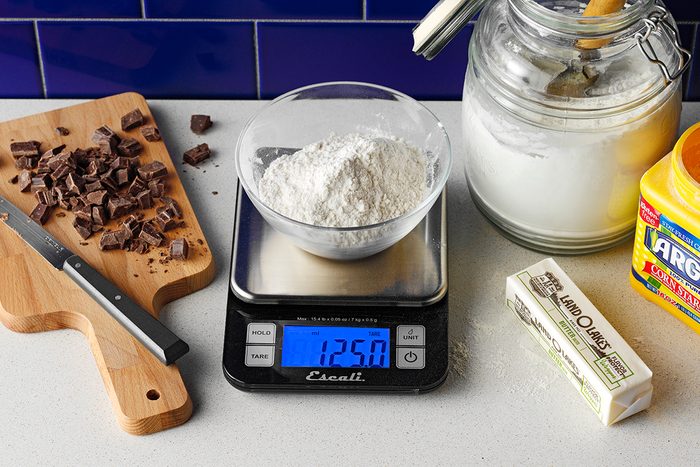Why Pro Bakers Measure Ingredients by Weight—and You Should, Too
Updated: Mar. 03, 2023

There's a reason you see a digital scale in every professional bakery. Doing this one little thing when measuring your ingredients is the key to the best cookies, cakes and breads.
Has this ever happened to you: You find a tasty-sounding cookie recipe and set about making it. The recipe calls for a cup of this and a half cup of that, so you pull out your trusty measuring cups and scoop away. You know you followed every instruction to a T, but the cookies turn out hard and crispy instead of being light and chewy. What happened?
Well, you probably added some extra flour and too much sugar—even though you followed the recipe. Learning how to weigh baking ingredients could be the solution to your woes. After all, I’m sure those cookies tasted amazing in the Test Kitchen where the pro bakers use weight instead of volume. Unlike cooking, where measurements can be flexible, baking is a science and measurements need to be extremely precise. Even an extra ounce here or there can cause a baking fail.
Don’t lose hope, though! Using a kitchen scale (like this one) is the best way to guarantee your baking success.
Weight Versus Volume
Measuring your baking ingredients using a scale instead of the measuring cups (which measure volume) is the best way to ensure the perfect amount of each ingredient. It might seem like a cup is a cup, but consider the density of your ingredients. A new bag of flour might be more compact than a less full, aerated one. And who knows that the recipe developer had in mind when she asked you to “lightly pack” that brown sugar? Using the scale removes all of these obstacles because an ounce of flour will always be an ounce of flour.
Not too long ago, we learned this lesson firsthand while trying to determine the best method for how to properly measure flour. We asked each of our Test Kitchen professionals measure out a cup – and the results were staggering! Some weighed as little as 3 ounces and others were as heavy as 5-1/2 ounces. Depending on the recipe, that discrepancy from the correct measurement of 4-1/4 ounces could make a big difference in the end results.
It’s Not All About Precision, Either
While it’s mostly about precision for the professionals, there are a few other reasons to use weight instead of volume in your home kitchen. While cups are the standard measurement for most U.S. recipes, European recipes use weight instead (thank you, Mary Berry!). Different recipe sources will also use different methods, so the only constant is weight.
Using weight also makes it easier to scale your recipes up and down. Who wants to measure out 1/3 teaspoon of baking powder or take the time to count out 12 cups of flour? It would be much easier to put the ingredients on the scale and let the weight do all the work for you.
Ingredient Weight Chart
If your recipe doesn’t have weight measurements (or you want to convert some family favorites), check out this handy weight chart.
- All-purpose or bread flour: 1 cup = 125 grams
- Cake four: 1 cup = 140 grams
- Self-rising flour: 1 cup = 125 grams
- Whole wheat flour: 1 cup = 120 grams
- Baking powder: 1 teaspoon = 4 grams
- Baking soda: 1 teaspoon = 6 grams
- Butter: 1/2 cup (1 stick) = 113 grams
- Granulated sugar: 1 cup = 200 grams
- Packed brown sugar: 1 cup = 220 grams
- Confectioners‘ sugar: 1 cup = 113 grams
- Cocoa powder: 1 cup = 85 grams
For more information about measuring the basics, check out our definitive guide for measuring liquids, dry ingredients and butter.
